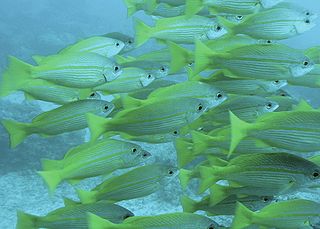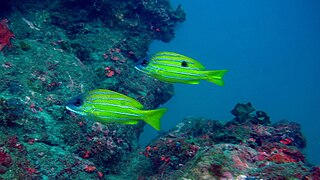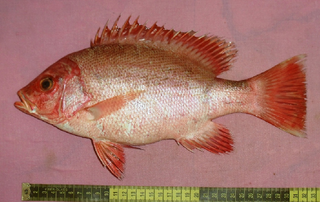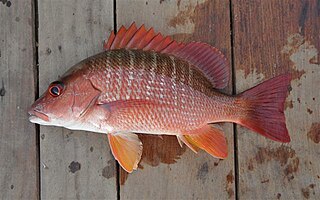
The bigeye snapper, also known as the bigeye seaperch, red sea lined snapper, golden striped snapper, rosy snapper, yellow snapper, or simply snapper, is a species of marine ray-finned fish, a snapper belonging to the family Lutjanidae. It is native to the Indian Ocean and the western Pacific Ocean. It is the type species of the genus Lutjanus.

The common bluestripe snapper, bluestripe snapper, bluebanded snapper, bluestripe sea perch, fourline snapper, blue-line snapper or moonlighter, is a species of snapper belonging to the family Lutjanidae. It is native to the Indian Ocean from the coast of Africa and the Red Sea to the central Pacific Ocean. It is commercially important and sought as a game fish. It can also be found in the aquarium trade.

Lutjanus is a genus of marine ray-finned fish, snappers belonging to the family Lutjanidae. They are found in the Atlantic, Indian, and Pacific Oceans. They are predatory fish usually found in tropical and subtropical reefs, and mangrove forests. This genus also includes two species that only occur in fresh and brackish waters.

Lutjanus quinquelineatus, the five-lined snapper, blue-striped snapper, blue-banded sea-perch, five-lined seaperch or gold-striped sea-perch, is a species of ray-finned fish, a snapper belonging to the family Lutjanidae. It is native to the Indian Ocean and the western Pacific Ocean.

The dog snapper, also known as the dogtooth snapper, pargue or snuggletooth snapper, is a species of marine ray-finned fish, a snapper belonging to the family Lutjanidae. It is native to the Atlantic Ocean. It is a commercially important species, and is popular for display in public aquaria.

The humpback red snapper, the paddletail, paddletail snapper or hunchback snapper, is a species of marine ray-finned fish, a snapper belonging to the family Lutjanidae. It has a wide Indo-West Pacific distribution. It is a commercially important species, as well as being sought after as a game fish. It is also a popular species for display in public aquaria. It has been reported to cause ciguatera poisoning.

Lutjanus fulviflamma, the dory snapper, blackspot snapper, black-spot sea perch, finger-mark bream, long-spot snapper, Moses perch or red bream, is a species of marine ray-finned fish belonging to the family Lutjanidae, the snappers. It has a wide Indo-Pacific distribution.

Lutjanus rivulatus, the blubberlip snapper, Maori snapper, blue-spotted seaperch, Maori bream, Maori seaperch, multi-coloured snapper, scribbled snapper, speckled snapper or yellowfin snapper, is a species of marine ray-finned fish, a snapper belonging to the family Lutjanidae. It is native to the Indian Ocean and into the Pacific Ocean.

Pristipomoides auricilla, the goldflag jobfish or the yellow flower snapper, is a species of ray-finned fish, a snapper belonging to the family Lutjanidae. It is found in the Indo-Pacific region.

Lutjanus russellii, Russell's snapper, Moses snapper, fingermark bream, Moses seaperch or Russell's sea-perch, is a species of marine ray-finned fish, a snapper belonging to the family Lutjanidae. It is native to the western Pacific Ocean.

Lutjanus madras, the Indian snapper, is a species of marine ray-finned fish, a snapper belonging to the family Lutjanidae. It is native to the western Pacific and Indian Oceans.

Lutjanus erythropterus, the crimson snapper, crimson seaperch, high-brow sea-perch, Longman's sea perch, red bream, saddle-tailed perch, small-mouth nannygai or smallmouth sea perch is a species of marine ray-finned fish, a snapper belonging to the family Lutjanidae. It is found in the Pacific and Indian Oceans.

Lutjanus vitta, the brownstripe red snapper, brownstripe snapper, broadband seaperch, brownstripe seaperch, one-band sea-perch, one-lined snapper or striped seaperch, is a species of marine ray-finned fish, a snapper belonging to the family Lutjanidae. It is native to the western Pacific and Indian Oceans.

Lutjanus malabaricus, the Malabar blood snapper, saddletail snapper, large-mouthed nannygai, large-mouthed sea-perch, Malabar snapper, nannygai, red bass, red bream, red emperor, red Jew, red snapper, saddletail seaperch, scarlet emperor or scarlet sea-perch, is a species of marine ray-finned fish, a snapper belonging to the family Lutjanidae. It is native to the Indian Ocean and the western Pacific, where it is found east to Fiji and Japan.

Lutjanus lemniscatus, the yellowstreaked snapper, darktail snapper, darktail seaperch or maroon sea-perch is a species of marine ray-finned fish, a snapper belonging to the family Lutjanidae. It is native to the western Pacific and Indian Oceans.

Lutjanus johnii, the Golden snapper, John’s snapper,big-scaled bream, fingermark bream, fingerbanger, fingermark seaperch, John's sea-perch, or spotted-scale sea perch, is a species of marine ray-finned fish, a snapper belonging to the family Lutjanidae. It is native to the western Pacific and Indian Oceans.

Lutjanus carponotatus, the Spanish flag snapper, stripey snapper, dusky-striped sea-perch, gold-banded sea perch, gold-stripe sea-perch, striped seaperch or stripey seaperch, is a species marine ray-finned fish, a snapper belonging to the family Lutjanidae. It is native to the western Pacific and Indian Oceans, from India to northern Australia.

Lutjanus monostigma, the one-spot snapper, onespot seaperch or Moses snapper, is a species of marine ray-finned fish, a snapper belonging to the family Lutjanidae. It is found in the Indo-Pacific region.

The Gorean snapper is a species of marine ray-finned fish, a snapper belonging to the family Lutjanidae. It is found in the eastern Atlantic Ocean.

The bluestriped snapper is a species of marine ray-finned fish, a snapper belonging to the family Lutjanidae. It is found in the southwestern Indian Ocean.





















